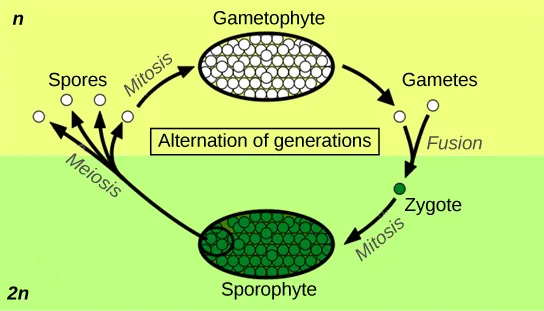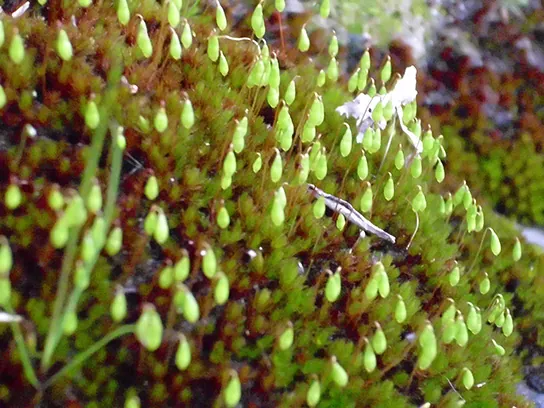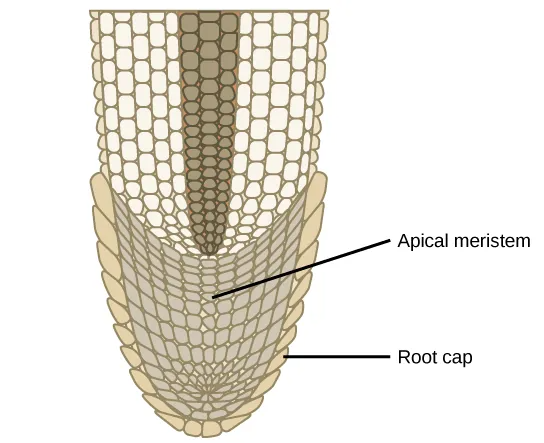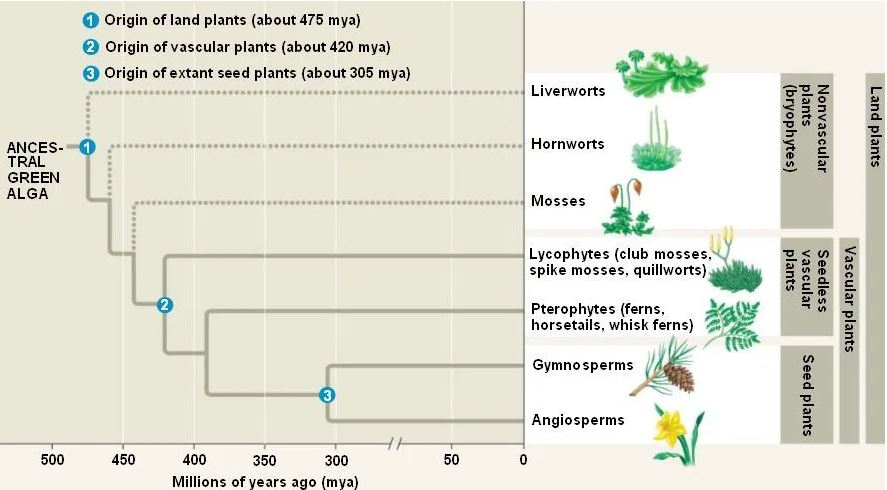25.1 Early Plant Life
Learning Outcomes
- Discuss the challenges to plant life on land
- Describe adaptations that allowed plants to colonize land
The kingdom Plantae constitutes large and varied groups of organisms. There are more than 300,000 species of catalogued plants. Of these, more than 260,000 are seed plants. Land plants arose within the Archaeplastida, which includes the red algae (Rhodophyta) and two groups of green algae, Chlorophyta and Charaphyta.
Plant Adaptations to Life on Land
As organisms adapted to life on land, they had to contend with several challenges in the terrestrial environment. The cell’s cytoplasm is a thick soup: in this medium, most small molecules dissolve and diffuse, and the majority of the chemical reactions of metabolism take place. Desiccation, or drying out, is a constant danger for an organism exposed to air. Even when parts of a plant are close to a source of water, the aerial structures are likely to dry out. Water also provides buoyancy to organisms. On land, plants need to develop structural support that is not necessary in aquatic plants. The organism is also subject to bombardment by mutagenic radiation, because air does not filter out ultraviolet rays of sunlight. Additionally, the male gametes must reach the female gametes using new strategies, because swimming is no longer possible. Therefore, both gametes and zygotes must be protected from desiccation. The successful land plants developed strategies to deal with all of these challenges. Not all adaptations appeared at once. Some species never moved very far from the aquatic environment, whereas others went on to conquer the driest environments on Earth.
To balance these survival challenges, life on land offers several advantages. First, sunlight is abundant. For aquatic plants, water acts as a filter, altering the spectral quality of light absorbed by the photosynthetic pigment chlorophyll. Second, carbon dioxide is more readily available in air than in water. Third, land plants evolved before land animals; therefore, until dry land was colonized by animals, no predators threatened plant life. This situation changed as animals emerged from the water and fed on the abundant plant life. In turn, plants developed strategies to deter predation: from spines and thorns to toxic chemicals.
Early land plants, like the early land animals, did not live very far from an abundant source of water and developed survival strategies to combat dryness. One of these strategies is called tolerance. Many mosses, for example, can dry out to a brown and brittle mat, but as water is available, the mosses will absorb it and are restored to their healthy green appearance. Another strategy is to colonize environments with high humidity, where droughts are uncommon. Ferns, which are considered an early lineage of plants, thrive in damp and cool places such as the understory of temperate forests. Later, plants moved away from moist or aquatic environments using resistance to desiccation, rather than tolerance. These plants, like cacti, minimize the loss of water to such an extent they can survive in extremely dry environments.
The most successful adaptation solution was the development of new structures that gave plants the advantage when colonizing new and dry environments. Four major adaptations contribute to the success of terrestrial plants. The first adaptation is that the life cycle in all land plants exhibits the alternation of generations, a sporophyte in which the spores are formed and a gametophyte that produces gametes. Second is an apical meristem tissue in roots and shoots. Third is the evolution of a waxy cuticle to resist desiccation (absent from some mosses). Fourth is lignin in the cell walls to help support structures off the ground. These adaptations all contribute to the success of the land plants, but are noticeably lacking in the closely related green algae—another reason for the debate over their placement in the plant kingdom. They are also not all found in the mosses, which can be regarded as representing an intermediate stage in adaptation to land.
Alterations of Generations
All sexually reproducing organisms have both haploid and diploid cells in their life cycles. Alternation of generations describes a life cycle in which an organism has both haploid and diploid multicellular stages (Figure 25.2). This type of life cycle is found in all plants.

In alternation of generations, the multicellular haploid form, known as a gametophyte, is followed in the developmental sequence by a multicellular diploid form, the sporophyte. The gametophyte gives rise to the gametes (reproductive cells) by mitosis. This can be the most obvious phase of the life cycle of the plant, as in the mosses, or it can occur in a microscopic structure, such as a pollen grain, in the seed plants. The evolution of the land plants is marked by increasing prominence of the sporophyte generation. The sporophyte stage is barely noticeable in non-vascular plants. In the seed plants, the sporophyte phase can be a towering tree, as in sequoias and pines.
Protection of the embryo is a major requirement for land plants. The vulnerable embryo must be sheltered from desiccation and other environmental hazards. In both seedless and seed plants, the female gametophyte provides protection and nutrients to the embryo as it develops into the new sporophyte. This distinguishing feature of land plants gave the group its alternate name of embryophytes.
Sporangia in Seedless Plants

The sporophyte of seedless plants is diploid and results from fusion of two gametes. The sporophyte bears the sporangia (singular, sporangium), a reproductive sac in which spores are formed (Figure 25.3). Inside the multicellular sporangia, the diploid sporocytes, or mother cells, produce haploid spores by meiosis. Meiosis reduces the diploid chromosome number, 2n, to haploid, 1n. The spores are later released by the sporangia and disperse in the environment. When the haploid spore germinates in a hospitable environment, it generates a multicellular gametophyte by mitosis. The gametophyte supports the zygote formed from the fusion of gametes and the resulting young sporophyte (vegetative form). The cycle then begins anew.
Plants that produce only one type of spore are called homosporous and the resultant gametophyte produces both male and female gametes on the same individual. Non-vascular plants are homosporous, and the gametophyte is the dominant generation in the life cycle. Plants that produce two types of spores are called heterosporous. The male spores are called microspores, because of their smaller size, and develop into the male gametophyte; the comparatively larger megaspores develop into the female gametophyte. All seed plants are heterosporous, and the sporophyte is the dominant generation.
The spores of seedless plants are surrounded by thick cell walls containing a tough polymer known as sporopollenin. This complex substance is characterized by long chains of organic molecules related to fatty acids and carotenoids: hence the yellow color of most pollen. Sporopollenin is unusually resistant to chemical and biological degradation. Sporopollenin was once thought to be an innovation of land plants; however, the charophyte Coleochaetes also forms spores that contain sporopollenin.
Gametangia in Seedless Plants
Gametangia (singular, gametangium) are structures on multicellular haploid gametophytes. In the gametangia cells give rise to gametes by mitosis. The male gametangium, called an antheridium, releases sperm. Seedless plants produce sperm equipped with flagella that enable them to swim in a moist environment to the archegonium, the female gametangium. The embryo develops inside the archegonium as the sporophyte. Gametangia are prominent in seedless plants, but are absent or rudimentary in seed plants.
Apical Meristems

Shoots and roots of plants increase in length through rapid cell division in a tissue called the apical meristem, which is a small mitotically active zone of cells found at the shoot tip or root tip (Figure 25.4). The apical meristem is made of undifferentiated cells that continue to proliferate throughout the life of the plant. Meristematic cells give rise to all the specialized tissues of the organism. Elongation of the shoots and roots allows a plant to access additional space and resources: light in the case of the shoot, and water and minerals in the case of roots. A separate meristem, called the lateral meristem, produces cells that increase the diameter of tree trunks.
Additional Land Plant Adaptations
As plants adapted to dry land and became independent from the constant presence of water, new organs and structures made their appearance. Early land plants did not grow more than a few inches off the ground, competing with each other for light. By developing a shoot and growing taller, individual plants captured more light. Because air offers substantially less support than water, land plants incorporated more rigid molecules in their stems. In small plants such as single-celled algae, simple diffusion suffices to distribute water and nutrients throughout the organism. However, for plants to evolve larger forms, the evolution of a conductive tissue for the distribution of water and solutes was a necessary. The evolution of vascular tissue in plants met these needs. The vascular system contains two types of conductive tissue: xylem and phloem. Xylem conducts water and minerals absorbed from the soil up to the shoot, while phloem transports food derived from photosynthesis throughout the entire plant. In xylem, the cells walls are reinforced with lignin, whose tough hydrophobic polymers help prevent the seepage of water across the xylem cell walls. Lignin also adds to the strength of these tissues in supporting the plant. The vascular tissues extend into the root of land plants. The root system evolved to take up water and minerals from the soil, and to anchor the increasingly taller shoot in the soil.
In land plants, a waxy, waterproof cover called a cuticle protects the leaves and stems from desiccation. However, the cuticle also prevents intake of carbon dioxide needed for the synthesis of carbohydrates through photosynthesis. To overcome this, stomata, pores that open and close to regulate flow of gases and water vapor, appeared in plants as they moved away from moist environments into drier habitats.
Water filters ultraviolet-B (UVB) light, which is harmful to all organisms, especially those that must absorb light to survive. This filtering does not occur for land plants. Exposure to damaging radiation presented an additional challenge to land colonization, which was met by the evolution of biosynthetic pathways for the synthesis of protective flavonoids and other pigments that absorb UV wavelengths of light and protect the aerial parts of plants from UV damage.
Plants cannot avoid being eaten by animals. Instead, they synthesize a large range of poisonous secondary metabolites: complex organic molecules such as alkaloids, whose noxious smells and unpleasant taste deter animals. These toxic compounds can also cause severe diseases and even death, thus discouraging predation. Humans have used many of these compounds for centuries as drugs, medications, or spices. In contrast, as plants co-evolved with animals, the development of sweet and nutritious metabolites lured animals into providing valuable assistance in dispersing pollen grains, fruit, or seeds. Plants have been enlisting animals to be their helpers in this way for hundreds of millions of years.
Visual Connection
Plant Evolution
Visual Connection



